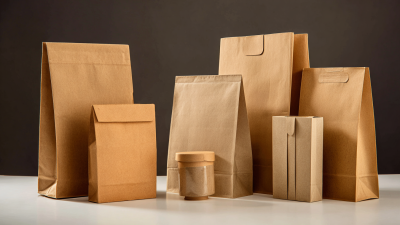Unlocking the Future: How Green Packaging Transforms Sustainability in E-Commerce
In today's rapidly evolving e-commerce landscape, the quest for sustainability has never been more critical, and "Green Packaging" emerges as a transformative solution at the forefront of this movement. As digital transactions continue to soar, the environmental impact of traditional packaging methods has come under scrutiny, prompting businesses to rethink their approaches. Green Packaging not only minimizes waste and reduces carbon footprints but also resonates with environmentally-conscious consumers who prioritize sustainable practices in their purchasing decisions. By adopting innovative materials and eco-friendly designs, companies can enhance their brand image while contributing to a healthier planet. This transformation is not merely a trend; it signifies a fundamental shift towards more responsible consumption and production methods in the digital age. The future of e-commerce hinges on how effectively we can integrate Green Packaging into our operations, setting a new standard for sustainability that benefits both businesses and the environment alike.

The Rise of Green Packaging in E-Commerce
The rise of green packaging in e-commerce is a response to the growing consumer demand for sustainable practices. With 89% of consumers shifting towards buying sustainable products, brands are increasingly adopting eco-friendly packaging solutions. This shift is not merely a trend but a necessity in today’s climate-conscious world, where environmental considerations are at the forefront of consumer choices.

In the context of a billion-dollar circular economy, green packaging plays a pivotal role in promoting sustainability in e-commerce. As the circular fashion movement gains momentum, companies are exploring innovative packaging options that reduce waste and minimize carbon footprints. By utilizing materials such as recycled paper and biodegradable substances, e-commerce businesses can align their operations with contemporary environmental standards, catering to a market that values low-carbon, green products. The integration of these practices not only enhances brand reputation but also contributes to the broader goal of sustainability that resonates with today's mindful consumers.
Innovative Materials Driving Sustainable Packaging Solutions
Innovative materials are at the heart of transforming sustainability in e-commerce packaging. As online shopping continues to surge, the environmental impact of traditional packaging materials, such as plastic and non-biodegradable substances, has come under scrutiny. In response, companies are turning to alternative materials that not only fulfill functional requirements but also minimize ecological footprints. Biodegradable plastics made from natural resources, such as cornstarch and sugarcane, are revolutionizing supply chains by offering a sustainable option that breaks down more easily in landfills.
Moreover, advancements in packaging design are set to enhance the efficiency of logistics while reducing waste. Companies are exploring mushroom-based mycelium packaging, which is both compostable and capable of providing robust protection for products during transit. Additional innovations, such as recycled paper and cardboard, are being optimized for performance, allowing brands to ship their products with a lower environmental impact. By prioritizing these innovative materials, e-commerce businesses are not only redefining their packaging strategies but also aligning themselves with the growing consumer demand for responsible and sustainable practices.
Unlocking the Future: Green Packaging in E-Commerce
The Role of Consumers in Promoting Green Packaging Practices
The rising demand for sustainable practices has positioned consumers as pivotal players in the transition towards green packaging in e-commerce. As more individuals become aware of their environmental footprint, they are increasingly seeking brands that prioritize eco-friendly options. This shift in consumer behavior not only influences purchasing decisions but also drives businesses to adopt sustainable packaging solutions. In essence, consumers can leverage their purchasing power to encourage companies to embrace practices that are kinder to the planet.
Moreover, consumer advocacy plays a significant role in promoting green packaging. By voicing their preferences through social media, reviews, and direct feedback, consumers hold brands accountable for their sustainability commitments. Many businesses are responding by developing innovative packaging materials that are biodegradable, recyclable, or made from recycled content. This symbiotic relationship between consumers and companies highlights the importance of consumer involvement in shaping a sustainable future, ultimately leading to greater environmental stewardship within the e-commerce landscape.
Challenges and Opportunities in Adopting Eco-Friendly Packaging
As e-commerce continues to expand, traditional packaging systems face mounting pressure to evolve towards greener alternatives. The adoption of eco-friendly packaging is not without its challenges. A report by Smithers Pira highlights that the global market for sustainable packaging is estimated to reach $500 billion by 2027, indicating a strong consumer shift toward environmentally responsible options. However, businesses often grapple with the higher initial costs associated with switching to eco-friendly materials. For instance, biodegradable options can be up to 30% more expensive than conventional plastics, causing hesitation among companies focused on profit margins.
Despite these hurdles, the opportunities presented by green packaging are significant. According to a study by Nielsen, 66% of consumers are willing to pay more for sustainable brands, which can incentivize companies to adopt green practices. Additionally, innovative materials such as mushroom packaging and algae-based alternatives are gaining traction, offering new avenues for sustainability in shipping. The challenge lies in balancing cost efficiency with innovation, yet those who successfully navigate this landscape can enhance brand loyalty and appeal to a growing demographic of environmentally conscious consumers.

Future Trends: The Evolution of Sustainable Packaging Technologies
Sustainable packaging technologies are on the rise as e-commerce continues to expand, driven by increased consumer demand for eco-friendly practices. According to a report from Smithers Pira, the global market for sustainable packaging is projected to reach $650 billion by 2027, highlighting the significant shift towards greener alternatives in the industry. Innovations in materials—such as biodegradable plastics, recycled cardboard, and plant-based packaging—are becoming mainstream, allowing e-commerce businesses to reduce their environmental footprint while still maintaining product integrity.
In addition, advancements in smart packaging technologies are set to revolutionize the way products are packaged and delivered. A recent study by Allied Market Research indicates that the smart packaging sector is expected to grow at a compound annual growth rate (CAGR) of 8.9%, reaching $45 billion by 2025. Features like QR codes and moisture sensors enhance not only the user experience but also contribute to sustainability efforts by minimizing waste and optimizing supply chain efficiency. As e-commerce platforms embrace these technologies, they not only respond to consumer preferences but also align their operations with broader environmental goals, paving the way for a more sustainable future.
Unlocking the Future: How Green Packaging Transforms Sustainability in E-Commerce
| Sustainable Packaging Material | Environmental Impact (CO2 kg per ton) | Recyclability (%) | Cost Comparison (% of traditional packaging) | Consumer Preference (%) |
|---|---|---|---|---|
| Biodegradable Plastics | 300 | 85 | 120 | 70 |
| Recycled Cardboard | 200 | 90 | 90 | 80 |
| Plant-Based Materials | 250 | 70 | 110 | 75 |
| Mushroom Packaging | 150 | 95 | 130 | 85 |
| Compostable Bags | 350 | 80 | 100 | 65 |
Related Posts
-

How to Choose the Right Custom Made Packaging Bags for Your Business Needs
-

Your Ultimate Guide to Custom Print Packaging: Boosting Brand Visibility with Data-Driven Strategies
-

The Ultimate Guide to Creating Effective Personalised Packaging Solutions
-

Inspiring Examples of Best Custom Box Solutions for Your Global Sourcing Needs
-

Overcoming Challenges in Costume Packaging: Navigating Quality and Efficiency Issues
-

Ultimate Guide to Choosing the Best Custom Packaging for Diverse Product Types